G. Henle Musikverlag Piano Music
- p.1 (Al - Ba)
- p.2 (Ba - Ba)
- p.3 (Ba - Be)
- p.4 (Be - Br)
- p.5 (Br - Ch)
- p.6 (Ch - De)
- p.7 (De - Ha)
- p.8 (Ha - Li)
- p.9 (Li - Mo)
- p.10 (Mo - Sa)
- p.11 (Sa - Sc)
- p.12 (Sc - Sc)
- p.13 (Sc - We)
-
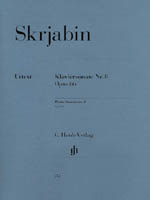
-
Scriabin, Alexander
Sonata No 8, op 66 (Rubcova/Schneidt)
20th Century (1912-13). In his last years, Scriabin realized a noble and great idea. Inspired by his study of theosophical writings, he dreamed of joining music, poetry, mime, architecture, light, color and even aromas to create a "Gesamtkunstwerk," and thus elevate human beings to a higher level of consciousness. This "Mysterium" was never completed, but his late piano sonatas-conceived as preliminary studies-enable us to see what moved Scriabin. He spent a particularly long time working on his ...
Read More
Category: Piano Solos
Item: 070450
Grade:
Price: $25.95
Availability: Ships in 6 to 9 Days - View Shopping Cart
-
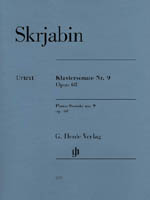
-
Scriabin, Alexander
Sonata No 9, op 68 (Rubcova/Schneidt)
20th Century (1912-13). Skrjabin's 9th Sonata is often referred to as the "Black Mass." Unlike the 7th Sonata, the so-called "White Mass," this name did not stem from the composer. He writes: "In the ninth sonata I came closer than ever before to the Satanic...". The mystic-dark sphere fascinated Skrjabin. Anyone who listens to this bizarre work will involuntarily become caught up in the diabolical vortex - the music heads towards the sonata's dramatic conclusion as if being pulled in an undertow...
Read More
Category: Piano Solos
Item: 083686
Grade:
Price: $14.95
Availability: Ships in 6 to 9 Days - View Shopping Cart
-
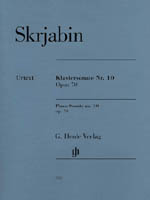
-
Scriabin, Alexander
Sonata No 10, op 70 (Rubcova/Schneidt)
20th Century (1912-13). Skrjabin's Tenth Sonata was composed at the same time as the two Sonatas Nos. 8 and 9 in winter 1912/13. It was probably finished at the latest in June 1913. According to Leonid Sabenejev's reminiscences Skrjabin had already performed parts of the sonata to friends in spring 1913, saying that "he had succeeded in simplifying the harmonies without destroying the Sonata's psychological complexity." Following the first performance in Moscow, a reviewer wrote: "The Tenth Sonat...
Read More
Category: Piano Solos
Item: 091504
Grade:
Price: $18.95
Availability: Usually Ships in 24 Hours - View Shopping Cart
-

-
Scriabin, Alexander
Sonatas Nos 1 - 10 (Rubcova/Schneidt)
In the years 2001-2014, G. Henle Publishers issued Urtext editions of the ten piano sonatas by Alexander Scriabin. The Scriabin specialist Valentina Rubcova from Moscow, the editor of these ten editions, studied all of the available sources for each work. In many cases, Henle's were the first-ever Urtext editions, offering these highly complex musical texts in an immaculate, uncluttered, newly engraved format that was truly a landmark event! Whoever would like to study all these ten sonatas can n...
Read More
Category: Piano Composer Folios
Item: 124375
Grade:
Price: $59.95
Availability: Ships in 10 to 15 Days - View Shopping Cart
-
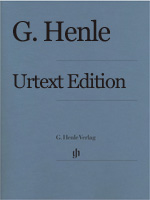
-
Soler, Padre Antonio
Selected Pieces
G. Henle URTEXT edition.
Category: Piano Composer Folios
Item: 018977
Grade:
Price: $26.95
Availability: Ships in 6 to 9 Days - View Shopping Cart
-

-
Staffan
Capricci
G. Henle URTEXT edition
Category: Piano Solos
Item: 013835
Grade:
Price: $16.95
Availability: Ships in 6 to 9 Days - View Shopping Cart
-

-
Strauss, Richard
Sonata in B, op 5 (Jost/Schaefer)
During his youth, Richard Strauss composed a large number of works for piano solo, among them numerous sonatas. Yet it was only the Sonata in B minor that he obviously considered important enough to want to see in print. It was composed in two versions, presumably between winter of 1880 and spring of 1881, and published one year later. Here, Strauss still plainly follows his compositional forebears from German Romanticism. The two middle movements of this demanding sonata in particular directly r...
Read More
Category: Piano Solos
Item: 130911
Grade:
Price: $13.95
Availability: Ships in 10 to 15 Days - View Shopping Cart
-

-
Tajcevic, Marko
Songs from Mur Island
G. Henle URTEXT edition
Category: Piano Composer Folios
Item: 004835
Grade:
Price: $13.95
Availability: Ships in 6 to 9 Days - View Shopping Cart
-

-
Tchaikowsky, Peter Ilyich
Chanson Triste, op 40, no 2
G. Henle URTEXT edition.
Category: Piano Solos
Item: 024959
Grade:
Price: $6.95
Availability: Ships in 6 to 9 Days - View Shopping Cart
-

-
Tchaikowsky, Peter Ilyich
Pieces (12), op 40
G. Henle URTEXT edition.
Category: Piano Composer Folios
Item: 024140
Grade:
Price: $23.95
Availability: Ships in 6 to 9 Days - View Shopping Cart
-

-
Tchaikowsky, Peter Ilyich
Pieces (6), op 19 (Vajdman/Schilde)
G. Henle URTEXT edition.
Category: Piano Composer Folios
Item: 038755
Grade:
Price: $23.95
Availability: Ships in 6 to 9 Days - View Shopping Cart
-

-
Tchaikowsky, Peter Ilyich
Seasons, op 37 bis (Vajdman)
G. Henle URTEXT edition. As well as Tchaikovsky's famous Piano Concerto, his extensive oeuvre for solo piano also makes an important contribution to romantic piano music. It includes "The Seasons" op. 37 - pleasant playable pieces that reflect a bygone bourgeois atmosphere and can therefore be assigned to the category of "domestic music." These twelve intimate mood-pictures enable the pianist to plot the course of the twelve months of the year. No. 11, "Troika", displays a Russian character parti...
Read More
Category: Piano Composer Folios
Item: 030527
Grade:
Price: $30.95
Availability: Ships in 6 to 9 Days - View Shopping Cart
-

-
Tchaikowsky, Peter Ilyich
Valse-Scherzo, op 34 (Kormarov/Schilde/Turban)
Romantic. Alongside the famous violin concerto, numerous other violin works by Tchaikovsky have found their way into the standard repertoire for violin. An outstanding example is the Valse-Scherzo, which sparkles with witty playfulness. He composed it in1877 for the violinist Josef Kotek, a close friend and student. Our editor, the Russian Tchaikovsky scholar Alexander Komarov, has ensured that this Henle Urtext edition is absolutely faithful to the sources. He was able to consult all of the sour...
Read More
Category: Piano Solos
Item: 112613
Grade:
Price: $17.95
Availability: Ships in 10 to 15 Days - View Shopping Cart
-

-
Tomasek
Selected Works
G. Henle URTEXT edition
Category: Piano Composer Folios
Item: 013848
Grade:
Price: $25.95
Availability: Ships in 6 to 9 Days - View Shopping Cart
-

-
Various
Chinese Piano Music: Works of the 20th Century (Xie)
This extraordinary edition includes a selection of piano works by Chinese composers from the second half of the 20th century. They are marked by Western influences while also reflecting the multifaceted folk music of China. They range from short character pieces to sonatinas, from simple song arrangements to multi-movement cycles. These works are of medium difficulty and offer a representative cross-section of a musical cosmos that remains largely unknown in Europe. Predominantly pentatonic in ch...
Read More
Category: Piano Solos
Item: 138155
Grade: Advanced
Price: $38.95
Availability: Usually Ships in 24 Hours - View Shopping Cart
-

-
Various
Classical Piano Sonatas
G. Henle URTEXT edition. Includes CPE BACH First Prussian Sonata in F; BEETHOVEN Sonata in E, op 14/1; Sonata in G op 14/2; Sonata in Gm op 49/1; Sonata in G op 49/2; CLEMENTI Sonata in G op 39/; HAYDN Sonata in C Hob. XVI-35; Sonata in G Hob. XVI-40; MOZART Sonata in C, K.545; Sonata in F K.280 (189e); Sonata in G K.283.
Category: Piano Classical/General Collections
Item: 013777
Grade:
Price: $25.95
Availability: Ships in 6 to 9 Days - View Shopping Cart
-

-
Various
Easy Piano Pieces, v.1
G. Henle URTEXT edition
Category: Piano Classical/General Collections
Item: 013808
Grade:
Price: $20.95
Availability: Usually Ships in 24 Hours - View Shopping Cart
-

-
Various
Easy Piano Pieces, v.2
G. Henle URTEXT edition The second volume of the Leichte Klavierstcke addresses itself to the somewhat more experienced pianist, and the level of difficulty of the individual pieces fluctuates between levels 3 and 6. The focal point here lies on works of the romantic era: starting with Mozart and Beethoven we stop to briefly enjoy some Schubert before reaching Mendelssohn, Schumann and Chopin, who are followed by Brahms, Liszt and Tchaikovsky. It was our intent to present different genres, such ...
Read More
Category: Piano Classical/General Collections
Item: 013809
Grade:
Price: $21.95
Availability: Ships in 6 to 9 Days - View Shopping Cart
-

-
Various
Henle Album - Music from Bach to Debussy
Includes 39 short works for piano by Bach, Scarlatti, Handel, Haydn, Mozart, Beethoven, Weber, Schubert, Mendelssohn, Chopin, Schumass, Liszt, Clara Schumann, Kirchner, Brahms, Dvorak, Grieg, Debussy, Skryiaben and Reger.
Category: Piano Classical/General Collections
Item: 043650
Grade:
Price: $8.95
Availability: Ships in 6 to 9 Days - View Shopping Cart
-

-
Various
Sonatinas, v.1 - Baroque to Pre-Classic (Herttrich/Kraus)
G. Henle URTEXT edition. Includes 25 works from CPE Bach, JCF Bach, Benda, Pistoia, Handel, Paganelli, Platti, Scarlatti and Soler.
Category: Piano Classical/General Collections
Item: 013869
Grade:
Price: $27.95
Availability: Ships in 6 to 9 Days - View Shopping Cart
-

-
Various
Sonatinas, v.2 - Classical (Herttrich/Kraus)
G. Henle URTEXT edition. Includes 21 Sonatinas from Cimarosa, Clementi, Diabelli, Ebert, Haydn, Hoffmeister, Hook, Kuhlau and Pleyel.
Category: Piano Classical/General Collections
Item: 013870
Grade:
Price: $30.95
Availability: Ships in 6 to 9 Days - View Shopping Cart
-

-
Various
Sonatinas, v.3 - Romantic (Herttrich/Kraus)
G. Henle URTEXT edition. Includes 8 Sonatinas from Fibich, Goetz, Heller, Kirchner, Raff, Reinecke and Schumann.
Category: Piano Classical/General Collections
Item: 009544
Grade:
Price: $30.95
Availability: Ships in 6 to 9 Days - View Shopping Cart
-

-
Vorisek
Selected Works
G. Henle URTEXT edition
Category: Piano Composer Folios
Item: 013853
Grade:
Price: $38.95
Availability: Ships in 6 to 9 Days - View Shopping Cart
-

-
Wagner, Richard
Isolda's Liebestod, from Tristan und Isolde (Liszt/Rahmer)
Category: Piano Solos
Item: 098619
Grade:
Price: $13.95
Availability: Ships in 6 to 9 Days - View Shopping Cart
-

-
Wagner, Richard
Spinnerlied, from The Flying Dutchman (Liszt/Scheideler)
Romantic. Based on the autograph score in Weimar and the composer's own revisions in the archives of the publisher Breitkopf & Härtel. -the publisher
Category: Piano Solos
Item: 100844
Grade:
Price: $13.95
Availability: Ships in 6 to 9 Days - View Shopping Cart
-

-
Wagner, Richard & Franz Liszt
Overture to Tannhauser Concert Paraphrase (Jost/Groethuysen)
Looking back in 1876, Liszt admitted candidly to the publisher Breitkopf & Hartel that his "Wagner Transcriptions" had "only served as modest propaganda for Wagner's noble genius, using the meager possibilities of the piano." In fact, around 1850, Wagner's operas Der Fliegende Hollnder, Tannhuser and Lohengrin - which would later be so successful - were only being performed at the Weimar Court Theatre under Liszt's baton. Liszt was inspired to compose his Tannhuser Paraphrase by performances i...
Read More
Category: Piano Solos
Item: 128851
Grade:
Price: $17.95
Availability: Ships in 10 to 15 Days - View Shopping Cart
-

-
Weber, Carl Maria von
Invitation to the Dance
G. Henle URTEXT edition.
Category: Piano Solos
Item: 013895
Grade:
Price: $11.95
Availability: Ships in 6 to 9 Days - View Shopping Cart
-

-
Weber, Carl Maria von
Selected Works
G. Henle URTEXT edition.
Category: Piano Composer Folios
Item: 009545
Grade:
Price: $20.95
Availability: Ships in 6 to 9 Days - View Shopping Cart
-

-
Weber, Carl Maria von
Sonata in C, op 24
G. Henle URTEXT edition.
Category: Piano Solos
Item: 016352
Grade:
Price: $25.95
Availability: Usually Ships in 24 Hours - View Shopping Cart
-
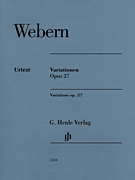
-
Webern, Anton
Variations, op 27 (Scheideler)
Following Alban Berg, Anton Webern is the second composer of the Second Viennese School to be included in the Henle catalog. Webern's music is known for its extreme brevity and strict organization. A performance of the Variations Op. 27 lasts less than ten minutes - a short period of time during which the audience experiences true extremes. Webern rehearsed the piece with several pianists, which resulted in surprisingly emotional aids to interpretation being handed down. Having consulted all of t...
Read More
Category: Piano Composer Folios
Item: 112527
Grade:
Price: $17.95
Availability: Usually Ships in 24 Hours - View Shopping Cart
- p.1 (Al - Ba)
- p.2 (Ba - Ba)
- p.3 (Ba - Be)
- p.4 (Be - Br)
- p.5 (Br - Ch)
- p.6 (Ch - De)
- p.7 (De - Ha)
- p.8 (Ha - Li)
- p.9 (Li - Mo)
- p.10 (Mo - Sa)
- p.11 (Sa - Sc)
- p.12 (Sc - Sc)
- p.13 (Sc - We)
More Options
- Use our Custom Order Page to special order items you can't find.
- Use our Catalog Order Page to order items from a printed catalog, or if you already know our catalog number for the item(s) you're interested in.
- And as always, feel free to E-mail us with your questions!
